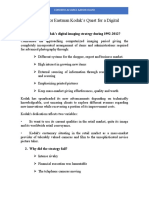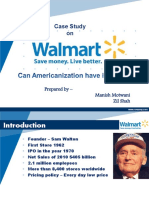Mattel
Mattel
Uploaded by
Fiona PesakCopyright:
Available Formats
Mattel
Mattel
Uploaded by
Fiona PesakOriginal Description:
Copyright
Available Formats
Share this document
Did you find this document useful?
Is this content inappropriate?
Copyright:
Available Formats
Mattel
Mattel
Uploaded by
Fiona PesakCopyright:
Available Formats
Mattel, Inc.
History:
Ruth and Elliot Handler and Harold Matt Matson founded Mattel in 1945 in South California. Elliot Handler soon took over the parts of his partner and put his main focus on the production of toys. Inspired by their daughters fascination with cutout dolls with changing clothes Mattel invented Barbie. Barbie soon leads Mattel to be the leading production in the toy industry. In 1960 Mattel became publicly owned and was listed in the New York and Pacific Coast Stock exchange. Only 5 years later Mattel made a sales top of 100 Million US Dollar and joint the Fortune 500. 1986 they acquire the Hong Kong based industry ARCO and create a joint Venture with Bandai, Japans largest toy company. In 1997 Mattels Global Manufacturing Principles were established. Mattel is the first global consumer products company that established a framework within which all of the companys manufacturing must be conducted and who applied such system to its facilities and core contractors all over the world.
Production:
In 2002 Mattel closed the last American factory and outsourced the production to China, which was the beginning of a chain of events that led to a scandal involving the lead contamination. About 65% of Mattels toys were made in China. Approximately half of them were manufactured in Mattels own plants. The contracts required vendors to undergo a review of
their production facilities and to agree to be audited under Mattels Global Manufacturing Principles.
Supplier:
In 1993 the two businessmen Cheung Shu-hung and Xie Yuguang with an investment of almost 4 million US dollars founded Lee Der in the booming Province Guangdong. From a first small order from Mattel, the Mattels orders increased and Lee Der dropped its other clients and focused on its future with Mattel. Since 1993 they never had quality problems, considers Xie Yuguang.
Issue:
On the 2nd of August 2007 the toy giant Mattel recalled almost 1 million toys produced by their supplier Lee Der in China. They stated that their toys were colored using lead-based paint. This, if children suck or jaw toys with high lead content, can even lead to death in some cases. The contaminated parts of the paint on the toys were 110,000 parts per million, instead of the 600 parts per million which is allowed by the U.S. Federal law. Two weeks later Mattel recalled 9 million more china-made toys from their supplier in Guangdong. A third recall took place, another two weeks later, which involved 800,000 toy products. Mattel, Inc. was not the first manufacturer who had to face a breakdown in the Chinese production chain. 70% of the worlds toys are made in China and most of them in Guangdong province, so this is not the first scandal to hit the industry. Due to that the Chinese government is improving its product regulations and even members of congress have called for amending current laws requiring more inspections of imports from China. Experts here say that many Chinese factory owners have to cut corner in making products and regularly cheap and illegal substitutes, because they are often under intense pressure to lower the production costs. Also the toy manufacturer Mattel was blamed for apparently failing to enforce safety standards in its supply chain. Even though Mattel has its own established safety checks, including independent audits of facilities and many of its own factories in China, that has not prevented them from this events.
This is a vendor plant with whom weve worked for 15 years; this isnt somebody that just started making toys for us, Robert A. Eckert, the chief executive of Mattel, said in an interview. They understand our regulations, they understand our program, and something went wrong. That hurts.
Consequences:
After Mattel, Inc. sent investigators to China - which identified Lee Der as the main supplier of the tainted products - the government suspended the companys export license. That caused a loss of 30 million US dollar as a result of the scandal. Although economists say that the cases have been damaging, they are unlikely to have a great influence to the strength of Chinas manufacturing industries. China even had an export boom and countrys sales trade has increased to more than 24 billion US dollar, the second-highest figure on record until 2007. Two weeks after the proclamation that Lee Der was suspended the companys export license, the head of the Chinese company, which was behind the recall, committed suicide. A spokeswoman for Mattel, Inc. released a statement saying, We were saddened to learn of this tragic news. The Consumer Product Safety Commission fined the big player in toy industry, Mattel, Inc. and his Fishers Price division 2.3 million US dollar for violation of Federal Regulations. Mattel agreed to the fine and no wrongdoing was admitted on the companys part.
The Logical Framework:
The US Agency of International Development invented the Logical Framework Approach in the late 60s. Since many years the European Union takes advantage of this method for development projects. The main tool is the so-called Logical Framework Matrix, also called Logframe. The Logframe is composed of five rows and (vertical logic) and four columns (horizontal logic). The five rows are used to describe 5 different types of events that take place as a project is implemented.
Vertical logic: Goal (main goal, impact - long term) Purpose (outcome - immediate) Outputs (measurable results) Activities (measures) Inputs
The vertical logic includes goal hierarchy (=project description). The four columns provide different types of information about the events in each column. Horizontal logic: Design summary (=project description) Indicators + Targets Monitoring Mechanism Risk + Assumptions
References: http://www.shyup.cn/images/Case6/1.pdf http://www.nytimes.com/2007/08/02/business/02toy.html http://www.msnbc.msn.com/id/20254745/ns/business-consumer_news/t/mattel-issuesnew-massive-china-toy-recall/ http://www.guardian.co.uk/uk/2007/aug/03/estheraddley.uknews4 http://www.guardian.co.uk/business/2007/aug/13/china http://www.telegraph.co.uk/finance/markets/2814037/Chinese-boss-of-toy-firm-involvedin-Mattel-recall-commits-suicide.html http://www.nytimes.com/2007/08/14/business/worldbusiness/14toy.html http://findarticles.com/p/articles/mi_m5072/is_1_23/ai_69259287/pg_10/ http://money.cnn.com/news/newsfeeds/articles/newstex/AFX-001318873781.htm?cnn=yes
You might also like
- Applichem (A) Abridged HoutDocument8 pagesApplichem (A) Abridged HoutManinder SinghNo ratings yet
- Mattel's Case Study AnswerDocument4 pagesMattel's Case Study AnswerMoni Vann67% (9)
- Eastman Kodak's Quest For A Digital FutureDocument3 pagesEastman Kodak's Quest For A Digital FutureSiddhi GodeNo ratings yet
- Assignmnet 3 BBADocument1 pageAssignmnet 3 BBAhammadNo ratings yet
- Case Study - Decision Tools - Arctic IncDocument2 pagesCase Study - Decision Tools - Arctic IncShahzeen Raza0% (1)
- Mattel and The Toy Recalls FinalDocument25 pagesMattel and The Toy Recalls FinalSimon Pollard100% (2)
- Analysis of Toy IndustryDocument2 pagesAnalysis of Toy IndustryManish PatelNo ratings yet
- Week 2 Case Study Belle Meade PlantationDocument7 pagesWeek 2 Case Study Belle Meade PlantationТинна Ш.No ratings yet
- Jot Case Analysis:: The 2013 CIMA Global Business Challenge in Partnership With BarclaysDocument25 pagesJot Case Analysis:: The 2013 CIMA Global Business Challenge in Partnership With BarclaysJo Anne V. GuevarraNo ratings yet
- SampleCase PDFDocument18 pagesSampleCase PDFAJNo ratings yet
- 1&2 Assignment # 5Document2 pages1&2 Assignment # 5tejasraiNo ratings yet
- EconomicsDocument7 pagesEconomicsDilshan KaviratneNo ratings yet
- Netflix - Group 6 - 1.8Document21 pagesNetflix - Group 6 - 1.8yogesh85100% (1)
- E Bay Acquisition of Skype: Group 2Document24 pagesE Bay Acquisition of Skype: Group 207anshuman0% (1)
- Subsequent Debit, Delivery Cost and Credit MemoDocument37 pagesSubsequent Debit, Delivery Cost and Credit MemoSrini Vasan100% (2)
- Mattel Toy-Crisis Management: Communication & PR ProjectDocument12 pagesMattel Toy-Crisis Management: Communication & PR ProjectAndradaTataruNo ratings yet
- Final Case Analysis Mattel and Toy SafetDocument10 pagesFinal Case Analysis Mattel and Toy SafetHuy Luong DANGNo ratings yet
- Mattel CaseStudyDocument28 pagesMattel CaseStudypraveen sagar100% (1)
- Mattel Recalls 2007: Communication Implications For Quality Control, Outsourcing, and Consumer RelationsDocument28 pagesMattel Recalls 2007: Communication Implications For Quality Control, Outsourcing, and Consumer RelationsSasha KhalishahNo ratings yet
- Mattel Toy RecallsDocument4 pagesMattel Toy RecallsMuskan M100% (1)
- Mattel Toys RecallDocument20 pagesMattel Toys RecallTariq ZebNo ratings yet
- MattelDocument28 pagesMattelAkshay Shukla100% (1)
- Case Study Mattel and Toy Safety Betty SDocument13 pagesCase Study Mattel and Toy Safety Betty SHaina XuNo ratings yet
- Mattel Corporation: Team 4Document11 pagesMattel Corporation: Team 4vmg_mayuresan100% (1)
- Mattel Case SolutionDocument7 pagesMattel Case SolutionMauricio CortesNo ratings yet
- Week 8 AssignmentDocument5 pagesWeek 8 Assignmentssregens82100% (2)
- Assignment 1 (M)Document13 pagesAssignment 1 (M)Sanjay Panicker100% (1)
- Case Study-Apple Activity 2Document11 pagesCase Study-Apple Activity 2Austin BrayNo ratings yet
- CaseAnalysis TRU S G GDocument17 pagesCaseAnalysis TRU S G GGovinda Kumar ManwaniNo ratings yet
- Mattel Case AnalsisDocument4 pagesMattel Case Analsismoatik2No ratings yet
- Assignment On Toyota1Document4 pagesAssignment On Toyota1Sirsha PattanayakNo ratings yet
- WalmartDocument12 pagesWalmartGlyka K. Riga100% (1)
- Research MethodologyDocument58 pagesResearch MethodologyRab Nawaz100% (2)
- PGP36412 GoogleCarDocument1 pagePGP36412 GoogleCarAYUSH VERMANo ratings yet
- IKEA Outsourcing ChallengeDocument2 pagesIKEA Outsourcing Challengesherine00No ratings yet
- Mast GlobalDocument3 pagesMast GlobalPiyush ChandraNo ratings yet
- Evaluating Lego's Decision To Partner With Tencent in ChinaDocument11 pagesEvaluating Lego's Decision To Partner With Tencent in ChinaSujäń ShähíNo ratings yet
- Evaluate Ebay'S International Business Strategies To Date. What Changes, If Any, Would You Suggest?Document7 pagesEvaluate Ebay'S International Business Strategies To Date. What Changes, If Any, Would You Suggest?ecuhmd0% (1)
- Downloadable Solution Manual For Essentials of Marketing Research A Hands On Orientation 1st Edition Malhotra Case 1.1 Dell 1Document21 pagesDownloadable Solution Manual For Essentials of Marketing Research A Hands On Orientation 1st Edition Malhotra Case 1.1 Dell 1dolly-sharmaNo ratings yet
- Business StudiesDocument23 pagesBusiness StudiesRichard Lancaster-ShanksNo ratings yet
- Open Innovation ApproachDocument3 pagesOpen Innovation ApproachPalash JainNo ratings yet
- LoeaDocument21 pagesLoeahddankerNo ratings yet
- Presentation 7Document9 pagesPresentation 7Hani ShehzadiNo ratings yet
- PIRG Trouble in Toyland 2021Document32 pagesPIRG Trouble in Toyland 2021Sinclair Broadcast Group - EugeneNo ratings yet
- Dell Globalization PaperDocument16 pagesDell Globalization Papervenkatrao253100% (1)
- Social Media Plan - Phuong Trinh Le - 77315752Document34 pagesSocial Media Plan - Phuong Trinh Le - 77315752Phuong Trinh LeNo ratings yet
- From Low Cost To Global LeadershipDocument14 pagesFrom Low Cost To Global LeadershipTanu Lahoti100% (1)
- Meditech Surgical CaseDocument1 pageMeditech Surgical Casemoonlit28No ratings yet
- Akamais Localization ChallengeDocument19 pagesAkamais Localization ChallengeErick MorenoNo ratings yet
- Exam 1 Review ProblemsDocument2 pagesExam 1 Review ProblemsAdamNo ratings yet
- Reverse Logistics and Green Supply ChainDocument17 pagesReverse Logistics and Green Supply ChainahahaNo ratings yet
- Cloud WarsDocument10 pagesCloud WarsAtharva Sachin KulkarniNo ratings yet
- Coffee PotDocument4 pagesCoffee PotGanesh PuriNo ratings yet
- Mergers Case StudyDocument5 pagesMergers Case StudyPreeti MishraNo ratings yet
- Final Slides Supply ChainDocument33 pagesFinal Slides Supply ChainghaziaNo ratings yet
- MGN832 Ca3Document29 pagesMGN832 Ca3Jyoti Arvind PathakNo ratings yet
- Case Study On: Prepared by - Manish Motwani Zil ShahDocument17 pagesCase Study On: Prepared by - Manish Motwani Zil Shahmanish14589No ratings yet
- BSE Case StudyDocument2 pagesBSE Case Studykowshik moyyaNo ratings yet
- EbayDocument24 pagesEbayYka Suajico100% (1)
- Mattel Toy RecallDocument8 pagesMattel Toy RecallK Shyam RenuNo ratings yet
- MattelDocument4 pagesMattelvishalsimsr12No ratings yet
- Main - Product - Report-Jinan Yuki Bearing Co., Ltd.Document24 pagesMain - Product - Report-Jinan Yuki Bearing Co., Ltd.zubair90No ratings yet
- Financial Data Analysis of Ferozsons LaboratoryDocument36 pagesFinancial Data Analysis of Ferozsons Laboratorymartain maxNo ratings yet
- Advanced Higher English Dissertation Title PageDocument7 pagesAdvanced Higher English Dissertation Title PageWriteMyApaPaperBatonRouge100% (1)
- Mugshot LetterDocument2 pagesMugshot LetterT.L. LangfordNo ratings yet
- Manual E-Learning HWS01Document8 pagesManual E-Learning HWS01Marshall SanchezNo ratings yet
- Discussion Paper On The Significant Risk Transfer in Securitisation (EBA-DP-2017-03)Document155 pagesDiscussion Paper On The Significant Risk Transfer in Securitisation (EBA-DP-2017-03)Robin MichaelNo ratings yet
- Assignment On International Financial ManagementDocument7 pagesAssignment On International Financial ManagementKiran NayakNo ratings yet
- Learning Activity Sheet # 1.4: Lesson Iv: Research Ethics: Summarizing, Paraphrasing and Quoting ACTIVITY 1: What I KnowDocument3 pagesLearning Activity Sheet # 1.4: Lesson Iv: Research Ethics: Summarizing, Paraphrasing and Quoting ACTIVITY 1: What I KnowLorenzo CohenNo ratings yet
- Puri MenDocument13 pagesPuri MenRichard PreschelNo ratings yet
- Green ComputingDocument7 pagesGreen Computingerwin.dee.cicsNo ratings yet
- Compensation & Reward ManagementDocument227 pagesCompensation & Reward ManagementjitendersharmajiNo ratings yet
- JCT D&B 2024 ExcerptsDocument18 pagesJCT D&B 2024 ExcerptsSriram Venkata RaoNo ratings yet
- Business Plan: Founders: Jack Smith - John DoeDocument37 pagesBusiness Plan: Founders: Jack Smith - John DoeRicco BenNo ratings yet
- SocioDocument36 pagesSocioTejas GuptaNo ratings yet
- PBill September'23Document16 pagesPBill September'23ajdubeyNo ratings yet
- Economía Política Syllabus I JuradoDocument9 pagesEconomía Política Syllabus I JuradoFELIPENo ratings yet
- Danske Bank Message Implement at Ion Guide Multiple Credit Advice (Edifact D.96A - Cremul)Document32 pagesDanske Bank Message Implement at Ion Guide Multiple Credit Advice (Edifact D.96A - Cremul)aNo ratings yet
- Practice Test 2 - Midterm - M4B PDFDocument2 pagesPractice Test 2 - Midterm - M4B PDFNguyễn Quốc HưngNo ratings yet
- Market Risk EvaluationDocument46 pagesMarket Risk EvaluationDesara_GJoka123No ratings yet
- One Page Advanced Squad LeaderDocument1 pageOne Page Advanced Squad LeadersfernandezNo ratings yet
- Teks PidatoDocument2 pagesTeks PidatoNovazira AFNo ratings yet
- Module - 1 NotesDocument20 pagesModule - 1 NotesSpoorthiNo ratings yet
- Ultimate SEO ChecklistDocument6 pagesUltimate SEO Checklistgaganpreetsingh84No ratings yet
- Access To Your Medical Benefits Just Got Easier: A Step-By-Step GuideDocument22 pagesAccess To Your Medical Benefits Just Got Easier: A Step-By-Step GuideNuranissaNo ratings yet
- Dunes AdjustedDocument8 pagesDunes AdjustedbigkstrongNo ratings yet
- Albularyo Folk Healing: Cultural Beliefs On Healthcare Management in Partido District, Camarines Sur, PhilippinesDocument28 pagesAlbularyo Folk Healing: Cultural Beliefs On Healthcare Management in Partido District, Camarines Sur, PhilippinesANGELICA AYCARDO FLORESNo ratings yet
- Barbara Creed The Monstrous Feminine 2007Document648 pagesBarbara Creed The Monstrous Feminine 2007laurarocha9100% (3)
- Scan V. CMSDocument14 pagesScan V. CMSJakob EmersonNo ratings yet
- Open Letter To Governor Abbott On Vaccine MandatesDocument2 pagesOpen Letter To Governor Abbott On Vaccine MandatesJeramy KitchenNo ratings yet

























































































